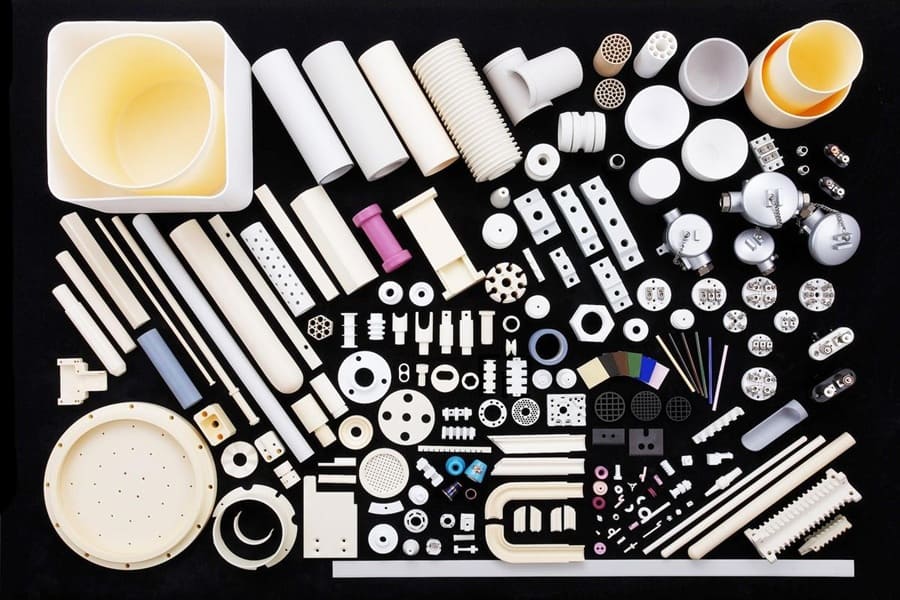Ceramic Materials: Properties and Applications Guide
Introduction
Ceramic materials, inorganic and non-metallic, are engineered through high-temperature sintering, offering exceptional hardness, thermal stability, and corrosion resistance. These attributes make ceramics indispensable across industries, from aerospace to biomedical applications. This article explores ceramic materials’ key properties and applications, supported by a detailed table, to highlight their versatility in industrial settings.
Properties of Ceramic Materials
Ceramic materials exhibit various mechanical, thermal, and electrical properties, making them suitable for diverse applications. Below are their primary characteristics:
- High Hardness: From 2.3 GPa (Macor) to 33 GPa (Boron Carbide), ensuring wear resistance.
- Thermal Stability: Maximum operating temperatures up to 1750°C (Alumina 99.95%), ideal for high-heat environments.
- Electrical Insulation: Volume resistivity up to >10¹⁷ ohm-cm (Macor), suitable for electronic applications.
- Mechanical Strength: Flexural strength ranges from 94 MPa (Macor) to 1800 MPa (Zirconia 3YZ), supporting structural roles.
- Low Thermal Expansion: CTE as low as 2.5 × 10⁻⁶/K (Silicon Nitride), ensuring dimensional stability.
Detailed Properties Table
The table below summarizes the key properties of various ceramic materials, based on industry data.
| Material | Density (g/cm³) | Flexural Strength (MPa) | Hardness (GPa) | Thermal Conductivity (W/mK) | CTE (10⁻⁶/K) | Max Temp (Air) (°C) | Dielectric Constant | Volume Resistivity (ohm-cm) |
| Alumina 96% | 3.75 | 200–300 | 12 | 25 | 6.3 | 1600 | 9.8 | >10¹⁴ |
| Alumina 99.7% | 3.95 | 250–350 | 14 | 33 | 6.5 | 1700 | 9.9 | >10¹⁴ |
| Alumina 99.95% | 3.98 | 500–600 | 18 | 45 | 7.5 | 1750 | 9.9 | >10¹⁶ |
| ZTA | 4.1 | 600 | 16 | 20 | 7 | 1500 | 10 | >10¹⁶ |
| ATZ | 4.18 | 850 | 21.5 | 20 | 7.5 | 1500 | 10 | >10¹⁶ |
| Zirconia 3YZ | 5.5 | 1800 | 14 | 6 | 8 | 1200 | 25 | >10¹² |
| Aluminum Nitride | 3.32 | 350 | 10 | 170 | 4.5 | 1200 | 8.8 | >10¹³ |
| Silicon Carbide | 3.1 | 410 | 28 | 102.6 | 4.02 | 1200 | N/A | 10²–10¹¹ |
| Boron Carbide | 2.52 | 420 | 33 | 20–40 | 90 | 1800 | 5–8 | N/A |
| Silicon Nitride | 3.2–3.4 | 730 | 15 | 25 | 2.5 | 1200 | 8 | >10¹⁴ |
| Shapal Hi M Soft | 2.88 | 300 | 3.8 | 92 | 4.8 | 1000 | 6.8 | >10¹⁵ |
| Macor | 2.52 | 94 | 2.3 | 1.5 | 9 | 800 | 6 | >10¹⁷ |
| Boron Nitride | 1.9 | 13–29 | N/A | 21 | N/A | 850 | N/A | >10¹⁴ |
Table Notes:
- Mechanical Properties: High hardness (e.g., 33 GPa for Boron Carbide) ensures durability in abrasive applications.
- Thermal Properties: High thermal conductivity (e.g., 170 W/mK for Aluminum Nitride) supports heat dissipation.
- Electrical Properties: High volume resistivity (e.g., >10¹⁷ ohm-cm for Macor) ensures reliable insulation.
Applications of Ceramic Materials
Ceramic materials are utilized across various industries due to their diverse properties. Below are their key applications:
- High-Temperature Applications: Silicon Carbide and Boron Nitride (up to 1800°C) are used in furnace linings and aerospace components like turbine blades.
- Electrical Insulation: Alumina (>10¹⁴ ohm-cm) and Aluminum Nitride (170 W/mK) are ideal for electronic substrates and heat sinks.
- Wear-Resistant Components: Silicon Nitride (15 GPa hardness) and Zirconia (1800 MPa strength) are used in bearings and cutting tools.
- Biomedical Applications: Zirconia (fracture toughness up to 17 MPa m¹/²) suits dental implants and joint replacements.
- Semiconductor Manufacturing: Shapal Hi M Soft (92 W/mK) supports precision components in semiconductor equipment.
- Prototyping: Macor’s machinability enables rapid prototyping of complex shapes.
Conclusion
Ceramic materials offer exceptional hardness, thermal stability, and electrical insulation, making them essential for applications in aerospace, electronics, and biomedical industries. Their diverse properties ensure reliability in demanding environments.
Advanced Ceramics Hub is a leading manufacturer and supplier of high-quality ceramic products in form of plates, sheets, rods, tubes, crucibles, substrates, and customized parts, offering customized solutions for various industrial and research applications.

